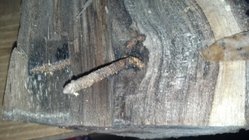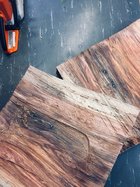- Joined
- Dec 23, 2015
- Messages
- 62
- Likes
- 168
- Location
- Ringgold, Georgia
- Website
- www.rickurbanwoodturner.com
I have a horror story about embedded objects in a magnolia I harvested from a fence row in an old community, but I'll leave that for another time and open this with the short version.
When cutting a log, if you don't use a metal detector first, at least be alert for ebonizing. Ebonizing is what happens when ferrous metal reacts with the tannin in the log, mainly in the heartwood. It turns the wood black, or at least dark, in many, but not all, species.
You can do this on purpose by putting some steel wool in some vinegar, let it soak for a little while or longer, and painting it on some wood. The affect on white oak is dramatic.
Once you start turning a blank continue being alert for the discoloration, because some objects can become totally engulfed over time (picture). In addition, be alert for changes in sound as you cut. A "tick, tick, tick" as you turn should be investigated.
When cutting a log, if you don't use a metal detector first, at least be alert for ebonizing. Ebonizing is what happens when ferrous metal reacts with the tannin in the log, mainly in the heartwood. It turns the wood black, or at least dark, in many, but not all, species.
You can do this on purpose by putting some steel wool in some vinegar, let it soak for a little while or longer, and painting it on some wood. The affect on white oak is dramatic.
Once you start turning a blank continue being alert for the discoloration, because some objects can become totally engulfed over time (picture). In addition, be alert for changes in sound as you cut. A "tick, tick, tick" as you turn should be investigated.


